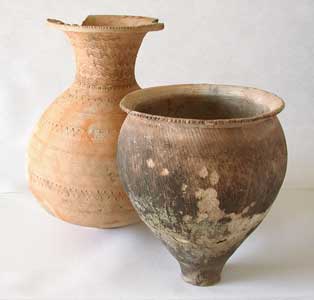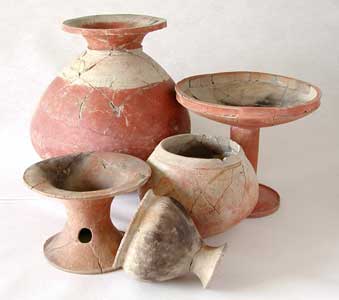Today i would like to speak of roots of Shintō/root Shintō.
First it is important to note that term Shintō should be revised because it is just an arctificial term invented in Heian period in order to distinguish local autochtonic beliefs from Buddhism and Taoism.
This term
was invented according to Chinese samples: in Chinese culture there are many
doctrines, each of which is called as "a way something".
As far as
Chinese culture is culture of written signs, many doctrines and concepts can be
pretty fully expressed in written signs and through them gradually can be
pretty fully acquired.
Due to this
gradually acquire appears the analogy of "way", i.e. gradually moving
to a certain aim.
Actually Shintō
is not a "way", it is not a systematic religion but just a heap
of rather amorphous so called "atmospheric
cults".
However, it is possible to single out some basic concepts which are
common for all traditions belonging to Shintō.
These basic
concepts are: tamashii/tama 魂 “vital energy”/”soul energy” and kami 神 “a super human being”.
Tamashii penetrates by the whole world and
fills everything, fills all beings and all things. All beings and things are
endowed tamashii in different degree: some have a lot of tamashii but some have little.
It is good to have a lot of tama. More tamashii
you have more mighty you are. Kami have a lot of tamashii and can endow
tamashii 魂 or take
it away.
Therefore the purpose of any rite of
Shintō is to save present tamashii and
get it more: in order to save present tamashii and get
more it is need to contact with kami.
Both of
these concepts (tamashii and kami) are traced back to Ainu concepts ramat –
“soul exists” and kamuy “super human being”.
Ainu are
the most ancient population of Japanese archipelago, Kuril islands, Sakhalin
and Kamchatka peninsula.
From the
point of view of physical anthropology Ainu have no similarities with any
population of Asia and Pasific Rim except people of Japanese Neolithic culture
or so called "Jomon culture" (about 13000 BC till about 500 BC.)
Jomon is
Japanese calque of English term 'cord mark', 'cord marked pottery' which
describes a characteristic feature of the pottery of this archaeological
culture and on which this culture or a group of cultures was named.
Jomon
pottery is the oldest pottery of the world and one of the most beautiful also:
Situation
in historical linguistics is analogous of that of physical anthropology.
Ainu
language is considered as an isolated by contemporary linguistics. Ainu
language differ radically from neighboor languages: Japanese, Korean, Nivkh,
Itelmen, Chinese, Tungusic languages and Austronesian languages.
It is not possible now to say where from exactly Ainu came to the Japanese erchipelago (But there are some obvious facts that tell us that Ainu came from South for example the fact that Jomon culture began its spread from the south of Japanese archipelago. But it is well known that they settled all over archipelago from southern Ryukyu till Hokkaido and also Kuril islands and southern half of Sakhalin and southern end of Kamchatka.
Toponyms of Ainu origin corroborate this fact, for example: Tsushima <- Ainu.: tuyma – "distant", Fuji <- Ainu: huci – "grandma", "kamuy of fireplace"; Tsukuba <- Ainu: tu ku pa – "head of two bows", Yamatai <- Ainu: ya ma ta i - «place where harbour deeply cuts the land".
Also many
examples of Ainu toponyms can be found in Kindaichi Kyousuke works.
Later, when
so called Old Korean came Ainu were one of the main component of forming
Japanese ethnicity. Research of DNA of Japanese population showed that most
widely spread Y-japlogroup is D2 which is main Ainu Y-haplogroup (about 86% of
Ainu have it).
The most
notable fact is that Japanese and Korean have similar mtDNA while Korean have
practically no Y-DNA D2. (The Japanese are basically mix of ancient Ainu and
ancient Korean) That means that Ainu took Korean women but not vice versa. This
fact tells us that the rulers were Ainu. Most of Japanese nobility is of Ainu
origin.
Also Ainu
influenced seriously on forming Japanese creed, i.e. Shintō.
It is
notable fact that Japanese terms tamashii/tama and kami sounds much alike Ainu
terms ramat and kamuy and also expresses practically the same concepts:
Explaining
the meaning of this concept of ramat Neil Gordon Munro quotes the explanations
that he received from Ainu elders (ekasi): "KotanPira said ramat was
the backbone of Ainu religion.
Rennuikesh,
eighty years old, very active and intelligent, who came from the north of
Hokkaido, said: 'Whatever has no ramat has nothing'. Nisukrek and other elders
agreed with this: 'ramat is all-pervading and indestructible'.
Word ramat
consists of two morphemes: ram which means
"soul"/"mind"/"heart" and at which is similar to
such verbs as an/oka and oma which mean "to be"/"to
exist". So it can be interpreted as "soul exists"/"vital energy
exist".
(It is notable fact that many verbs of Ainu
language designating mental activity, are formed with ram root: ram
– to "think", e-ram-an – to "understand", e-ram-iskar
– "not to understand", e-ram-as – “to rejoice to something”)
Following
to Neil Gordon Munro it is possible to state that ramat is very much
alike to the Polynesian mana.
Every thing
and every being has ramat. One thing has a lot of ramat another
has little but nothing can exist without ramat. Ramat cannot be
annihilated.
When beings die or when things are broken their ramat leaves them but doesn't disappear and goes to another place.
So we can
see that features of ramat are very close to that of tama.
Also it is
interesting to note that tamashii/tama originated from the word ramat by its
sound:
In Ainu
language [ ɾ ] can easily become [ tɾ
] [ tl ][ dl ] [ t ] [ d ] [ l ]. In Old Japanese initial r was prohibited and
also there were no consonant claster and close syllables so Ainu word ramat
could become only tama/tamatV/tamasV in Old Japanese.
(Here sign
"V" means an unidentified vowel sound.)
As for
kamuy here there are some versions of etymology but following to John Batchelor
I think word kamuy consists of three morphemes: ka + mu
+ i and interpreted its meaning as 'something over us" or a
"super human being".
It should
be noted that concept kamuy differs seriously from European concepts
deus / god / Gott / dios / deux because European god (God of christianity) is a
transcendental being opposite to this world while kamuy exists in the
neighborhood of people and people can easily get kamuy mosir (island of
kamuy) and also people can become kamuy.
Because of
it, the word kamuy should not be translated as dew /god / Gott / dios /
deux into European languages. I think the best way is to leave the word kamuy
without any translation at all and explain its meaning with a certain context.
And
etymology of Japanese kami is the following: Old Ainu (Upper Jomon Ainu) ka-mu-'i
[kamuj] -> Old Japanese kamɯ -> Modern Japanese kami.
Meaning kami is completely the same as meaning of kamuy.
Kamuy has a lot of ramat and can
endow or take away ramat to other beings. Kamuy which endow ramat
are good, kamuy which take ramat away are bad.
Every event
of Ainu traditional life can be described in terms of ramat and kamuy. Any act
of Ainu tradition is intended to save and to magnify the existing ramat.
Because of it a thing which has much ramat and which can magnify ramat
is good thing; while thing which takes ramat away is bad.
Best way to
get more ramat is to communicate with kamuy. To communicate with kamuy we need
a special artifact – inaw – literary i-naw means "shaved",
"curled". Inaw A baton with savings
It is considered as an universal
pure thing for storage, getting or transfer ramat.
Having
offered inaw we set a cahnnel between our island/world and island/world of
kamuy. And by this channel ramat of kamuy flows to us.
The origin
of inaw is unclear, but there are ideas that it could origin from dogū - clay figurines of Jomon epoch of unknown means:
These
figurines are considered as substitutes of human sacrifice by some
anthropologists and inaw as they are development of dogū
have the same function.
But more
notable fact it that in shintō exist the same items as inaw. I
mean gohei 御幣 and and seminawa (締縄 or 標縄) or just nawa
縄 (word nawa itself seems to
originate from Ainu word naw/i-naw).
Some researchers, for example W.Aston, J. B. Sansom incorrectly interpreted gohei and nawa as development of sacrifice of phloem, hemp and dresses while under the influence of Ainu inaw which were substitutes even in Ainu culture, sacrifices got a form of gohei and nawa.
Japanese mechanically reproduced remotely an anthropomorphous form inaw,
without understanding its real content. Only this can explain why substitutes
of fabrics have the form, reminding substitutes of human sacrifices.
Thus we
have the following: tama/ramat is a clot of "living" a
concentration of spiritual energy or even just general energy. Tama/ramat
penetrates by the whole world and fills everything, fills all beings and all
things.
All beings
and things are endowed tama/ramat in different degree: some have a lot
of tama/ramat but some have little. More tama you have more mighty you
are. It is good to have a lot of tama.
Therefore
the purpose of any rite of Shintō/Ainu traditional creed is to save present tama/ramat
and get more.
Kami/kamuy is everything that has a lot of tama/ramat
and can endow tama other beings.
Kami/kamuy is all outstanding and
unusual, somehow, for example: thousand-year cedar, stone of a freakish form,
falls, mountain of Fuji, founder of the Panasonic company, emperor Meiji, master
of a calligraphy or, for example, famous musician or writer.
It is very
important to understand that often kami /kamuy is not any
personal/anthropomorphous being or a subject or a thing which can be presented,
touched or, in general, be felt by means of five feelings.
Much more
often kami /kamuy is certain amorphous force, for example, force of an
attraction of Earth to the Sun also is a kami/kamuy, forces operating in
an atomic nucleus between protons and neutrons also are kami/kamuy, and
other similar phenomena also are kami/kamuy.
The purpose of any rite of Shintō is
to save present tama/ramat and
get it more: in order to save present tama/ramat and get
more it is need to contact with kami/kamuy.
Does anybody have any questions?



















